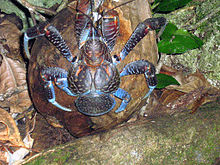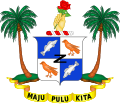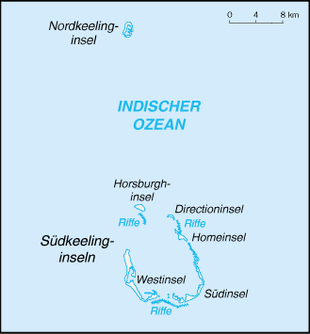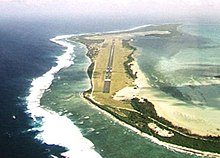Coconut islands
| Cocos (Keeling) Islands | |||||
| Coconut Islands (Keeling Islands) | |||||
|
|||||
| Official language | English | ||||
| Capital | West Iceland | ||||
| Form of government | Australian outskirts | ||||
| Head of state | Queen Elizabeth II | ||||
| Head of government | Barry Haase | ||||
| surface | 14.2 km² | ||||
| population | 550 | ||||
| Population density | 39 inhabitants per km² | ||||
| currency | Australian dollar (AUD) | ||||
| Time zone | UTC + 6½ | ||||
| ISO 3166 | CC , CCK, 166 | ||||
| Internet TLD | .cc | ||||
| Telephone code | +61 891 | ||||
| Postal code: 6799 | |||||
The Cocos Islands , also known as Keeling Islands , ( English Cocos Islands or Keeling Islands) , officially Territory of Cocos (Keeling) Islands are an archipelago in the Indian Ocean and are an Australian outer area . It is named after the local coconut palm .
location
The archipelago is located about 2930 km northwest of Perth , 3685 km west of Darwin , 960 km southwest of Christmas Island and more than 1000 km southwest of Java and Sumatra . The closest mainland point to Australia is Cape Low Point on the North West Cape Peninsula with a distance of 2109 km.
population
In 2005 the population was 628, by August 2011 it had fallen to 550. In the 2016 census, 244 people were listed. The total land area is 14.2 km². There are more than 400 Cocos Malays , an ethnic group that formed on the islands throughout history.
The main island with an airport is West Island . About 130 people live there, about 420 live on Home Island . The other islands are not permanently inhabited.
geology
The Cocos Islands consist of the two atolls North Keeling and South Keeling , which have formed at a distance of 25 kilometers on the peaks of about 5000 meters high submarine volcanoes, which are known as the Cocos Rise . They are part of a largely submarine ridge that extends to Christmas Island. The atolls are connected to a plateau that is 700 to 800 meters deep. Charles Darwin toured the atolls (the only ones he ever examined) in 1836 and developed a theory of their formation that is accepted to this day.
The atolls have a total land area of about 14 km². They are level and flat, the highest point is just nine meters above sea level. The tidal range is no more than two meters. Both atolls are coral islands that rise on average three to five meters above sea level and enclose a shallow lagoon in a ring. While they rise relatively steeply from the sea on the outside, they gently slope down towards the lagoon.
geography
The smaller northern atoll, North Keeling, consists of only a single, C-shaped island about 2.0 km long and 1.3 km wide. It has been under strict nature protection since 1986 and is part of the Pulu Keeling National Park .
The southern atoll, South Keeling, consists of 26 islands which enclose a pear-shaped lagoon with a diameter of about nine kilometers and a depth of up to twenty meters. The largest island, West Island, is about ten kilometers long and half a kilometer wide. There are no rivers or lakes on the islands. The only freshwater resources are shallow subterranean duckweed formed on some of the larger islands by rainwater floating on the heavier salt water.
The Cocos Islands are almost antipodal to the Cocos Island (Costa Rica) .
Flora and fauna

Due to their remote location, there were no land mammals on the Cocos Islands prior to human settlement. There are numerous seabirds: 24 bird species have been counted in the Pulu-Keeling National Park, including the red-footed booby with more than 30,000 breeding pairs, white frigate bird , ariel frigate bird and the endemic Keeling common rail . There are green turtles and hawksbill turtles . The only species of sea serpent sighted in the southern atolls is the platelet sea serpent . In the sea around the islands there are numerous molluscs , fish species, crustaceans , echinoderms and reef-forming hard corals .
Since the Cocos Islands were never connected to a mainland, plant seeds could only be brought in by wind, water or birds before human settlement. In a geological environment characterized by volcanism and coral growth, relatively few plant species developed. 61 types of plants have been counted on the Cocos Islands. Pisonia , coconut palms , velvet leaves , tea plants and grasses of the purslane wedge grow on the atolls, and kelp forests , seagrass meadows and tropical seaweed in the waters of the atolls .
| Cocos Island | ||||||||||||||||||||||||||||||||||||||||||||||||
|---|---|---|---|---|---|---|---|---|---|---|---|---|---|---|---|---|---|---|---|---|---|---|---|---|---|---|---|---|---|---|---|---|---|---|---|---|---|---|---|---|---|---|---|---|---|---|---|---|
| Climate diagram | ||||||||||||||||||||||||||||||||||||||||||||||||
| ||||||||||||||||||||||||||||||||||||||||||||||||
|
Monthly average temperatures and rainfall for Cocos Island
Source: Bureau of Meteorology, Australia, data: 1977-2006
|
|||||||||||||||||||||||||||||||||||||||||||||||||||||||||||||||||||||||||||||||||||||||||||||||||||||||||
history
discovery
The islands are said to have been discovered in 1609 by William Keeling , a captain of the British East India Company . However, there is no evidence to support this thesis. Only in a Dutch atlas from 1659 is the first mention of the "Cocos Eylanden", in 1703 the British hydrographer Thornton called them "Keeling Islands". A first detailed description can be found in 1753 in the book "Zeefakkel" by the Dutchman Gerard Hulst van Keulen. The British hydrographer James Horsburgh made precise nautical maps of these waters in 1805 and called the islands "Cocos Keeling Islands". In the following years several ships ran aground off the islands (1825 the Mauritius from France and 1826 the Sir Francis Nicholas Burton and 1834 the Earl of Liverpool from Great Britain ).
Start time
In 1826 the Dutch settled the former British Commissioner of Borneo , Alexander Hare , with his entourage and Malay serfs on the islands off their colony of Java . He cultivated West Island , Horsburgh Island, and Direction Island , where he produced coconut oil . In 1831 Hare left the islands and died en route to Britain. His administrator John Clunies-Ross from Scotland then appropriated the islands. He also produced coconut oil, which he successfully sold in Dutch Java. The islands also served as a stopover for whaling ships en route to Antarctica. Clunies-Ross established an authoritarian rule on the islands with its own laws and its own money that was only valid on its islands, which was only abolished in 1978. A British commission should check the conditions on the island. However, the British found no reason to intervene. However, the British rejected Clunies-Ross's wish for British rule over the island. In 1841 he therefore hoisted the Dutch flag due to his good trade relations with Java, but this was forbidden to him by the Dutch government.
British occupation
After the death of John Clunies-Ross in 1854, his son John George took over the islands. In 1857 Great Britain accidentally officially took possession of the Cocos Islands. The colonial administration's ship was actually supposed to occupy the Cocos Islands north of the Andaman Islands . John George Clunies-Ross brought more workers, mostly prisoners from Java, to the islands. There were numerous uprisings and looting.
After the death of his father, the new owner, George Clunies-Ross, abolished forced labor in 1871 and replaced the prisoners with Malay workers. In 1876 a cyclone destroyed over half of the coconut plantations. Clunies-Ross rebuilt the islands' infrastructure. In 1901 the "Eastern Extension Telegraphy Company" built a relay station for their subsea cable network on Direction Island. Another cyclone devastated the islands completely in 1909, 90% of the palm trees and 95% of the houses were destroyed. After the destruction of his life's work, George Clunies-Ross died in 1910 and his son Sydney Clunies-Ross took control of the islands. He had two Malays who are said to have murdered a fellow countryman sentenced to death and sunk alive in the sea with weights on their feet.
First World War
A radio station was also built on Direction Island in 1910. During the First World War , cable and radio stations on the island were the target of an attack by a German landing company of the small cruiser SMS Emden on November 9, 1914 . During the attack, the SMS Emden was discovered and attacked by the Australian light cruiser HMAS Sydney . The small remaining German crew returned fire, and the Sydney even turned, but turned back when it became clear that the Emden was not following and fired again at the Emden , where there were dead. The ship was so badly damaged in this battle that it had to be put on the reef by its own crew and abandoned. The Emden landing corps, which had remained behind in the battle between the warships, crossed over to Sumatra with the schooner Ayesha and later reached the Arabian coast with extraordinary difficulties with the German steamer Choising and from there via Constantinople (Istanbul) home.
Second World War
After the First World War, all the islands were settled and the population was 1,450 in 1940, whose supplies became increasingly critical as a result of the Second World War . Due to the living conditions on its islands, Sydney Clunies-Ross narrowly escaped indictment by the British Anti-Slave League.
To protect the cable station from the Japanese, coastal artillery was stationed on Horsburgh Island and infantry on Direction Island. Nonetheless, a Japanese warship shelled the islands in 1942 and there were numerous air raids by the end of the war. On the night of May 8 to May 9, 1942 , Ceylon artillerymen mutinied from the garrison on Horsburgh Island. Their leader was the artillery sergeant Gratien Fernando , who convinced his comrades that Asia should be reserved for the "Asians". Their act, known as the Cocos Islands Mutiny , was put down and three of them, including Fernando, were sentenced to death. They were the only British Commonwealth soldiers executed for mutiny during World War II . In the heaviest air raid in August 1944, 27 houses were destroyed and several people were killed. Sydney Clunies-Ross died shortly afterwards. From March to May 1945, the Allies built a runway on western Iceland. 8,300 soldiers were stationed on the Cocos Islands.
Australian occupation
In 1946 the runway was closed and the military withdrew. The islands' economic situation deteriorated. Sydney Clunies-Ross' son John-Cecil took over the islands, but could barely stop the migration of workers despite new houses and electricity. The runway was reopened in 1952 as a stopover for civil aviation. In 1955, Australia took over the islands in its territory through the Cocos (Keeling) Islands Act 1955. In the following years, cyclones destroyed the coconut plantations that had been rebuilt after the war. It was not until 1968 that the Australian government became aware of the feudal conditions on the islands. After a visit in 1971, a member of the government drew up a report on the maladministration on the islands. In 1974 the UN demanded a report from Australia on the Cocos Islands.
Finally, in 1978, the Australian government bought most of the islands from John-Cecil Clunies-Ross for A $ 6.25 million. For the first time democratic elections were held and Clunies-Ross island money was abolished. A school was built and medical care was provided. In the 1984 referendum, a majority of the islanders voted to stay with Australia. The copra production had to be stopped in 1987 because of inefficiency. The population is now hoping for tourism. Former island owner John-Cecil Clunies-Ross also sold his last property on the islands in 1992 after going bankrupt after a failed ship investment.
The Cocos Islands lie within Australia's migration zone . This means that on the island landing boat people (so-called boat people ) did not apply for asylum in Australia you ask questions and they in immigration detention in Australia are set.
economy
In 1979 a post office was set up which issues postage stamps and thus generates income for the island community. In 1987 copra and coconut oil production, until then the main source of income for the islanders, was stopped. Local fishing and the cultivation of bananas, vegetables and papayas contribute to the diet, but most food, like all other goods, must be imported. In 1999, imports amounted to two million AUD 2002 to AUD eleven million; they were not matched by any exports. In 2000, the Australian and regional administrations supported a research project to produce high-quality carbon fibers from coconut products. In 2000, the island's own Internet top-level domain .cc was sold to a US radio station, which represents a continuous source of income. The unemployment rate of 11.3% found in the 2006 census is presumably set too low; Estimates go up to a rate of 65%. A relaxation of the local job market is expected from the establishment of a center for Muslim tourists from the Pacific region, which will offer 79 jobs.
Others
Western Australia law applies to the territory . There are 4 police officers stationed on the archipelago.
See also
Web links
- Territories of Australia: Cocos (Keeling) Islands. Australian Government, Department of Infrastructure, Regional Development and Cities
- Review of: Noel Crusz: The Cocos Islands mutiny. Fremantle (WA) 2001. In: Journal of the Australian War Memorial ( Memento from September 16, 2013 in the web archive archive.today ).
Individual evidence
- ↑ rulers.org
- ↑ Coco-Malay language : Pulu Kokos (Keeling), Malay language : Wilayah Kepulauan Cocos (Keeling)
- ↑ https://www.cia.gov/library/publications/the-world-factbook/geos/print_ck.html
- ↑ https://www.cocoskeelingislands.com.au/
- ↑ https://www.environment.gov.au/topics/national-parks/pulu-keeling-national-park/history/cocos-keeling-islands-history
- ↑ Census 2011 of the Australian Bureau of Statistics (English), accessed April 28, 2015
- ↑ http://www.censusdata.abs.gov.au/census_services/getproduct/census/2016/quickstat/901021002
- ↑ Pulu Keeling National Park: Geology , accessed June 7, 2015
- ↑ Pulu Keeling National Park: Overview , accessed on June 7, 2015
- ↑ Pulu Keeling National Park: Fauna , accessed June 7, 2015
- ↑ Pulu Keeling National Park: Flora , accessed June 7, 2015
- ^ Bureau of Meteorology, Australia: Klimainformationen Cocos Island. World Meteorological Organization, accessed April 6, 2012 .
- ^ Regional Surveys of the World: The Far East and Australasia 2003 . 34th Edition. P. 145 f. Routledge 2002. ISBN 1-85743-133-2 Online on Google Books , in English, accessed September 19, 2011
- ^ Australian Bureau of Statistics: 2006 Census Quick Stats , accessed October 2, 2011.
- ↑ theaustralian.com.au : Paige Taylor: Administrator to head Cocos Islands , The Australian, September 1, 2011, in English, accessed September 19, 2011
- ↑ https://www.worldstatesmen.org/Cocos_Islands.html
Coordinates: 12 ° 10 ′ S , 96 ° 52 ′ E









